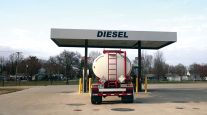Fuel Prices Take Another Leap
This story appears in the March 14 print edition of Transport Topics.
U.S. retail diesel prices shot up another 15.5 cents last week in the largest one-week increase in nearly three years, as the national average price reached $3.871 a gallon, the highest since October 2008, the Department of Energy said.
Diesel has now risen 14 straight weeks from its Nov. 29 price of $3.162 a gallon and is 96.7 cents a gallon more expensive than it was in the comparable week of 2010, DOE reported after its March 7 survey of fueling stations.
The diesel-fuel increase was the steepest since a 22.6-cent jump on May 26, 2008.
DOE also reported the retail gasoline average rose 13.7 cents to $3.52 a gallon. Gasoline has risen 13 out of the past 14 weeks, and is now 76.9 cents more expensive than a year ago.
Diesel is at its highest price since it was $3.875 on Oct. 6, 2008, while gasoline has not been as expensive since Sept. 29, 2008.
“The rapid rise in retail fuel obviously derives mostly from unrest in the Middle East and North Africa, especially Libya, that pushed crude up,” Neil Gamson, an economist at DOE’s Energy Information Administration, told Transport Topics. “There is no shortage of crude.”
Crude oil reached $105.44 a barrel on the New York Mercantile Exchange March 7, its highest since Sept. 23, 2008, Bloomberg News reported. On March 10, it closed at $102.70.
People in trucking differed on how these high prices would affect the industry.
“I’ve been hearing from some trucking executives and industry trackers that fuel surcharges will protect fleets from this, but I totally disagree with that assessment,” Chris Brady, president of consulting firm Commercial Motor Vehicle Consulting, Manhasset, N.Y., told TT.
“Everyone knows that fuel surcharges don’t make up for all the traveling that fleets have to do,” Brady said. “Plus, fleets have just recently gotten pricing power over shippers, but with this large fuel jump, a lot of fleets will have trouble getting both larger fuel surcharges as well as higher shipping rates. I can see this driving many companies out of business.”
Myron “Mike” Shevell, chairman and CEO of the Shevell Group, Elizabeth, N.J., which operates 2,640 tractors and 6,250 trailers in its subsidiaries, agreed the price spiral has hit hard.
“This just came out of nowhere . . . and is killing our operations, and is also affecting many of the products we need, like tires,” Shevell told TT.
“Then, you have a lot of shippers who don’t realize what’s been happening and don’t want to pay a proper fuel surcharge,” Shevell, who also is chairman of the New Jersey Motor Truck Association, added. “We’re not the airlines that can just slap a $50 increase on customers.”
The Shevell Group ranks No. 50 on the Transport Topics Top 100 list of for-hire carriers in the United States and Canada.
“Everyone is scrambling, but at the end of the day, this could have a devastating effect on a very fragile economy,” Shevell said. “It’s going to be a challenge of unbelievable proportion.”
Joseph Cowan, chairman and CEO of Cowan Systems, Baltimore, was more sanguine about larger trucking companies such as his own.
“The real story is the small guy, who doesn’t get the same kind of discount that large fleets can, will find it difficult to stay in business,” Cowan told TT. “It’s like handing them a 20,000-pound block to take up the hill, and consequently, there will be a lot more failures.”
Cowan Systems, which ranks No. 86 on TT’s list, operates 700 company-owned tractors, contracts with 370 owner-operators and has 2,700 trailers.
Cowan said his shippers have been paying the weekly fuel surcharge increases without complaint.
“It is part of our rate contract,” he said. “Every Monday, our fuel surcharges to clients are updated to reflect the latest prices.”
Cowan said that more freight is being handled by brokers, and truckers who depend mostly upon them can be hurt.
“The fuel surcharge is nearing 50 cents a mile, and we visited a broker to discuss a job,” he said. “They quoted us a price of $1.10 per mile, including the surcharge. We all laughed and just walked out.”
The EIA forecast that crude oil would stay above $100 a barrel for the rest of this year and throughout 2012. It also predicted sharply higher retail fuel prices than it had projected just last month.
In its Short-Term Energy Outlook issued March 8, EIA predicted that retail diesel would cost $3.90 in the second quarter, up 44 cents from its forecast in February, with prices of $3.87 for the final six months of 2011 and $3.88 in 2012.
EIA now forecasts that gasoline will hit $3.72 in the second quarter and $3.58 cents in 2012.




